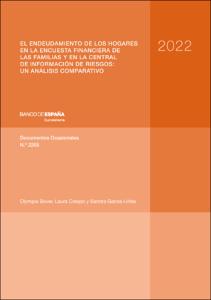El endeudamiento de los hogares en la Encuesta Financiera de las Familias y en la Central de Información de Riesgos: un análisis comparativo
Authors
Issue Date
16-Mar-2022
Physical description
43 p.
Abstract
El objetivo de este estudio es analizar la calidad de la información sobre endeudamiento recogida por la Encuesta Financiera de las Familias (EFF). Para ello, implementamos un cruce de los datos de esta con los datos administrativos de la Central de Información de Riesgos (CIR), que contiene, con carácter mensual, todo el universo de préstamos vivos de más de 6.000 euros contraídos por personas físicas con entidades financieras en España. Teniendo en cuenta las diferencias entre ambas fuentes en relación con la información que recogen, construimos y comparamos diversas medidas de endeudamiento a nivel de hogar. Para minimizar las diferencias asociadas a las discrepancias en la composición del hogar según el padrón y la EFF, realizamos el análisis tanto en la muestra enlazada total como en un subconjunto de hogares comparables. Nuestros resultados muestran que, una vez controladas por las limitaciones del enlace, las medidas de endeudamiento calculadas con la EFF y con la CIR son similares. La proporción de hogares con deuda hipotecaria es del 25,8 % en la EFF y del 29,9 % en la CIR.
The aim of this study is to analyse the quality of the information on indebtedness gathered by the Spanish Survey of Household Finances (“EFF” by its Spanish initials). To this end, we match EFF data with the administrative data from the Central Credit Register (“CIR” by its Spanish initials), which every month details all outstanding loans in excess of €6,000 arranged by individuals with financial institutions in Spain. Given the differences between the two sources in terms of the information they gather, we construct and compare various measurements of household indebtedness. In order to minimise the differences associated with the discrepancies in household composition according to the municipal population register and the EFF, we analyse both the total linked sample and a subset of comparable households. Our findings show that, after controlling for the limitations of the link, indebtedness calculated with the EFF and the CIR is similar. 25.8% of households have mortgage debt according to the EFF, versus 29.9% according to the CIR. Within indebted households, the median mortgage debt recorded in the EFF is only 0.5% lower than the figure according to the CIR. Non-mortgage debt differences are bigger, but not substantial. 18% of households have non-mortgage debt according to the EFF, versus 23% according to the CIR, and the median debt is 10% lower in the EFF. Moreover, the detailed information provided by the survey on the characteristics of households and their respective debts makes it possible to identify the age of the reference person and the existence of debts shared with individuals who are not members of the household as being the characteristics that have the most bearing on the discrepancies between the EFF and the CIR. The findings of this analysis will help improve the gathering of information and the protocols for interviewing households for the EFF.
The aim of this study is to analyse the quality of the information on indebtedness gathered by the Spanish Survey of Household Finances (“EFF” by its Spanish initials). To this end, we match EFF data with the administrative data from the Central Credit Register (“CIR” by its Spanish initials), which every month details all outstanding loans in excess of €6,000 arranged by individuals with financial institutions in Spain. Given the differences between the two sources in terms of the information they gather, we construct and compare various measurements of household indebtedness. In order to minimise the differences associated with the discrepancies in household composition according to the municipal population register and the EFF, we analyse both the total linked sample and a subset of comparable households. Our findings show that, after controlling for the limitations of the link, indebtedness calculated with the EFF and the CIR is similar. 25.8% of households have mortgage debt according to the EFF, versus 29.9% according to the CIR. Within indebted households, the median mortgage debt recorded in the EFF is only 0.5% lower than the figure according to the CIR. Non-mortgage debt differences are bigger, but not substantial. 18% of households have non-mortgage debt according to the EFF, versus 23% according to the CIR, and the median debt is 10% lower in the EFF. Moreover, the detailed information provided by the survey on the characteristics of households and their respective debts makes it possible to identify the age of the reference person and the existence of debts shared with individuals who are not members of the household as being the characteristics that have the most bearing on the discrepancies between the EFF and the CIR. The findings of this analysis will help improve the gathering of information and the protocols for interviewing households for the EFF.
Publish on
Documentos Ocasionales / Banco de España, 2205
Other versions
Subjects
Endeudamiento; Hogares; Análisis comparativo; Datos de encuesta; Datos administrativos; Indebtedness; Households; Comparative analysis; Survey data; Administrative data; Métodos Econométricos y Estadísticos; Economía del consumo y del ahorro; España
Appears in Collections:












